STALIN AND HITLER DIVIDE EUROPE
Soviet Minister of Foreign Affairs Vyacheslav
Molotov and his counterpart and fellow socialist Joakim von Ribbentrop of Germany divided Europe
between themselves in “zones of interest” with a treaty signed in Moscow on August
23, 1939. The “zones of interest” were to become targets of attacks by either or
both of the socialist dictatorships. Poland was the first victim of this treaty followed
by a Soviet invasion of Estonia and Latvia. Finland
became the next target on Nov 30, 1939. That war, one of many between Finland and Russia
became known as the “Winter War.”
THE WINTER WAR
The
Soviet Union’s aim was to assimilate Finland. They established a Quisling type
“government” by appointing Soviet residents in a puppet regime, which they
claimed to be the official government of Finland. These puppets were based in Terijoki,
the first town that the Russians overran across the border. That Terijoki
“government” was now, according to minister Molotov the official regime of Finland
and the only regime that the Soviets would recognize as a partner in peace negotiations.
That declaration unified the Finnish population with the
realization that their very existence
was at stake and even the Finnish socialists participated almost unanimously and
heroically in defending their country. The Finns put up , despite their underdog status, a
stiff resistance to the Soviet invaders. Soviet premier Khrushchev overestimated in his
memoirs that the Soviet losses were 1 million men. The enormous Soviet losses were not a
result of Finnish superiority in modern weapons. Finland was, in fact, very poorly armed.
The socialists in the Finnish parliament had been opposed to defense spending, so
when the Soviet Union with it’s 160 million people attacked Finland with 3.5 million
people the Finns were short of troops, they also were short of weapons.
THE MOLOTOV COCKTAIL
The Finns had very poor
defenses against tanks. They had a few cannon, but they were cumbersome to move in the
snow, so a great number of them were overrun
by the attacking Russian troops. The Finns started to use a bottle filled with flammable
liquids to destroy Russian tanks. The original bottle was filled with gasoline, and a rag wrapped around the throat of the bottle. The
rag was set on fire before the bottle was thrown at the tank. Upon impact the gasoline
burst in flames. The best location to throw the bottle was on top of the engine, where
engine lubricants were present and where the air intake dragged the fire into the engine.
This was to be known as the Molotov Cocktail.
Later versions of the Molotov cocktail were a
mix of gasoline, kerosene and tar. The tar clung on to the surface better, and produced
more smoke. The ignition method also evolved
from a burning rag outside the bottle to an igniter which was inside the bottle and
started the fire upon impact. The bottle used
was a .5 liter alcohol bottle. |
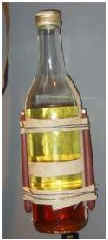 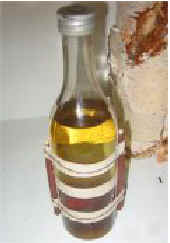 |
WHO CAME UP WITH THE NAME “MOLOTOV COCKTAIL”
To my knowledge, no one has been identified
as the originator of the term “Molotov Cocktail.”
Hotell Kämp in Helsinki became the center for foreign press that came to Finland
to report on the Winter War. It is assumed that the Molotov Cocktail name was invented by a foreign war correspondent, who had an ironical
bent. Hoisting one for Molotov, by burning one of his tanks in the process, has sarcasm
and mockery all in one word. Who first used the term for the first time is unclear. Someone with access to major newspapers from Dec.
1939 could check who first used that term in their article. Donald Day of the Chicago
Times is one suspect.
WHO HOISTED THE FIRST MOLOTOV COCKTAIL?
| The burning bottles had been used
before the Winter War, but it was during that war when they were first identified as “Molotov Cocktails.” The issue is then,
who was the first to take the burning bottle into use during that war. The book
“Marskin Ritarit,” which chronicles the exploits of the 191 men who have
received the highest Finnish war decoration, the Mannerheim Cross, gives lieutenant Kullervo Sippola the honor of introducing the
burn bottle into the Winter War. Sippola was
born Oct. 31, 1914. He was a foreman for a building contractor, and had made several
inventions. Sippola was an outstanding
soldier. He did not get the Mannerheim Cross for his use of the Molotov cocktail in
destroying Russian tanks, but for his proficiency to destroy tanks with a cannon. |
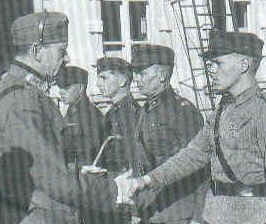 |
|
Marshal Mannerheim hands Sippola the
Mannerheim Cross in Sept. of 1942. |
Sippola
was known to hoist a few drinks when he was on leave. Once he had left a Helsinki watering
hole with a happy group of friends. A general, who had never smelled gunpowder, and who
had spent the war behind a desk , but who was used to receive salutes met Sippola’s group on a Helsinki street. Sippola paid no attention to the
general. The general, annoyed for not being saluted yelled after Sippola “
Lieutenant, what did you forget? Sippola turned around, took a few steps to stand in front
of the general, and Sippola then hit the general square on the jaw. The general was flat
on his back on the asphalt when Sippola calmly responded “ General, Sir, that’s
what I forgot.” Recipients of the nations highest military order do have a few
privileges. One of them is, that reports about gross misbehavior are filed in the round
file.
On
June 13, 1944 the Russians attacked Sippola’s positions. He had to get out from a
trench and run over a narrow road. He was shot during the attempt. Her fell down in the
trench, dead.
WHAT HAPPENED TO MOLOTOV?
| Molotov
was a particularly unpleasant person. As an example of Molotov’s style, below is a
snippet of a speech he gave Aug 1, 1940:
“I
will not stop to evaluate our relationship with the USA, because one cannot say anything
good about it. We have found out, that some in the US do not like the success of our
foreign policy in the Baltic countries.” (The “policy success” he refers to
was the Soviet forced occupation and pillaging of the Baltic countries) “One can
admit that that we are not interested in their opinions, because we can take care of our
business without the help of those unhappy gentlemen. The fact that US officials have
illegally refused to deliver the gold that we have recently bought from banks of Lithuania,
Latvia and Estonia, gives occasion to our angriest protest.” (The Soviets had begun
their occupation by looting all the banks in the above-mentioned countries. Now Molotov
demanded, that gold owned by the looted banks which was safely abroad, should also be part
of their plunder. Shamefully Sweden, caved in and handed over the gold stored in Sweden.)
|
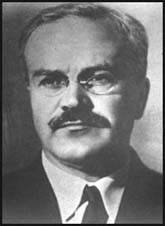 |
It was downhill for Molotov after Khrushchev won the power struggle after
Stalin’s death. The person cult that Molotov had enjoyed stopped overnight and
printers were busy to print new history books, now without any photos or mention of
Molotov. Factories and other things named after him, changed names. The freighter
“Vyacheslav Molotov” became “Baltica” and so on. Molotov managed to
save his neck, but he was booted from the politburo and the communist party. He never got over his arrogance, bossiness and
unpleasant demeanor. It was reported about him in his last years that he was cutting ahead
the local women in the food lines. By then Molotov was a “non person” so the
matshuskas were not shy to tell him what they thought of him. Molotov died in 1984. With
the blood of thousands on his hands, he will have an infamous place in history. Still, in an irony of history his name will be
remembered mainly through the Molotov cocktail, which was named to mock him.
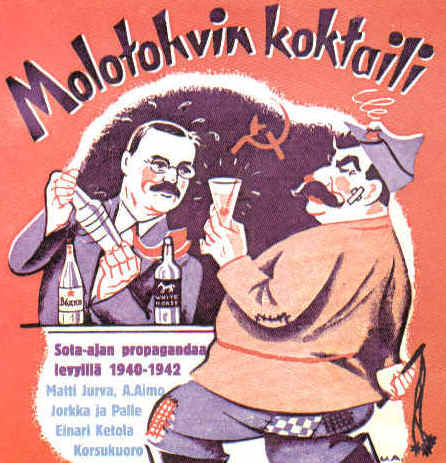
CD Cover from 2002. Molotov and Stalin are
still remembered in songs mocking them.
Author: Rainer Langstedt
Spencer, NY Email: valby@baka.com




